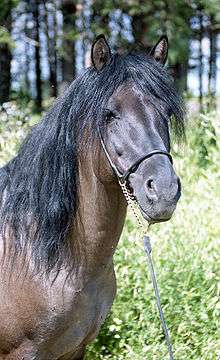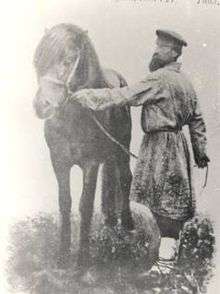Vyatka horse
The Vyatka or Viatka (Russian: Вятская лошадь, vyatskaya loshad) is an endangered breed of horse native to the former Vyatka region, now the Kirov Oblast of the Russian Federation. It is mainly found there and in the Udmurt Republic.[3] It is named for the Vyatka River.[4]:512
 Vyatka stallion | |
| Other names | |
|---|---|
| Country of origin | Russian Federation |
| Traits | |
| Distinguishing features | Female height: 140 cm[1]:339 Female weight: 400 kg[1]:339 |
| Notes | |
| Conservation status: FAO (2007): endangered[2]:99 | |
History

The Vyatka was influenced by the climate and terrain of the Kirov, Udmurtia and western Perm regions; Estonian horses and Kleppers brought to northern Russia in the fourteenth century by Novgorod colonists may have affected its conformation, as may later imports of Estonian horses for mining work in the Ural Mountains.[1]:338 The Vyatka was valued for its endurance, speed and frugality. By the middle of the nineteenth century it was considered the best horse for pulling troikas; some were exported from the Vyatka region, including to Poland.[1]:339
In 1917 the breed was virtually extinct; some efforts at re-establishment were made after the Russian Revolution.[5] Numbers in the Kirov and Udmurtia were estimated at 2000 in 1980.[1]:339 In 2003 the known population numbered 560,[3] and in 2007 the Vyatka was on the Endangered List of the FAO.[2]:99
Characteristics
The average height at the withers of Vyatka mares is 140 centimetres (13.3 hands; 55 inches), and the average weight 400 kilograms (880 lb).[3] The usual coat color was originally a striped dun with primitive markings – zebra stripes and a dorsal stripe;[4]:512 it has become more variable, and may also be roan, bay, brown or chestnut, or occasionally black.[1]:339[4]:512
References
- N.G. Dmitriev, L.K. Ernst (1989). Animal genetic resources of the USSR. FAO animal production and health paper 65. Rome: Food and Agriculture Organization of the United Nations. ISBN 9251025827. Archived 13 November 2009. Also available here, archived 29 September 2017.
- Barbara Rischkowsky, D. Pilling (eds.) (2007). List of breeds documented in the Global Databank for Animal Genetic Resources, annex to The State of the World's Animal Genetic Resources for Food and Agriculture. Rome: Food and Agriculture Organization of the United Nations. ISBN 9789251057629. Accessed October 2014.
- Breed data sheet: Vyatskaya/Russian Federation. Domestic Animal Diversity Information System of the Food and Agriculture Organization of the United Nations. Accessed October 2014.
- Valerie Porter, Lawrence Alderson, Stephen J.G. Hall, D. Phillip Sponenberg (2016). Mason's World Encyclopedia of Livestock Breeds and Breeding (sixth edition). Wallingford: CABI. ISBN 9781780647944.
- Hendricks, Bonnie L., Anthony A. Dent (2007) International Encyclopedia of Horse Breeds Revised ed. Norman: University of Oklahoma Press ISBN 978-0-8061-3884-8
| Wikimedia Commons has media related to Vyatka horse. |